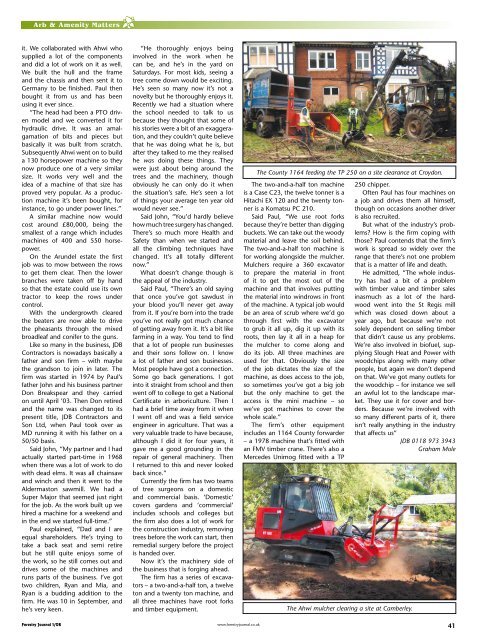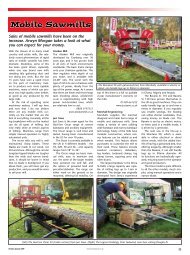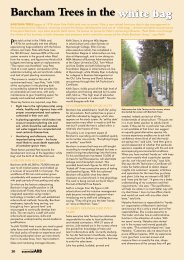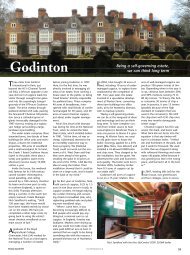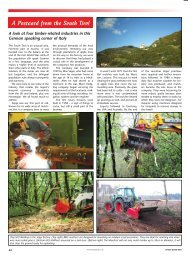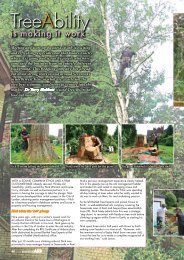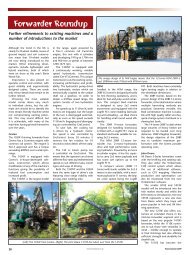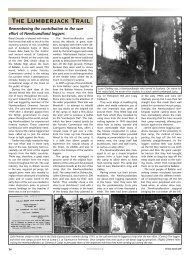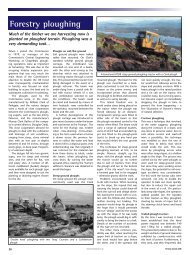AHWI RT100 - Forestry Journal
AHWI RT100 - Forestry Journal
AHWI RT100 - Forestry Journal
Create successful ePaper yourself
Turn your PDF publications into a flip-book with our unique Google optimized e-Paper software.
Arb & Amenity Matters <br />
it. We collaborated with Ahwi who<br />
supplied a lot of the components<br />
and did a lot of work on it as well.<br />
We built the hull and the frame<br />
and the chassis and then sent it to<br />
Germany to be finished. Paul then<br />
bought it from us and has been<br />
using it ever since.<br />
“The head had been a PTO driven<br />
model and we converted it for<br />
hydraulic drive. It was an amalgamation<br />
of bits and pieces but<br />
basically it was built from scratch.<br />
Subsequently Ahwi went on to build<br />
a 130 horsepower machine so they<br />
now produce one of a very similar<br />
size. It works very well and the<br />
idea of a machine of that size has<br />
proved very popular. As a production<br />
machine it’s been bought, for<br />
instance, to go under power lines.”<br />
A similar machine now would<br />
cost around £80,000, being the<br />
smallest of a range which includes<br />
machines of 400 and 550 horsepower.<br />
On the Arundel estate the first<br />
job was to mow between the rows<br />
to get them clear. Then the lower<br />
branches were taken off by hand<br />
so that the estate could use its own<br />
tractor to keep the rows under<br />
control.<br />
With the undergrowth cleared<br />
the beaters are now able to drive<br />
the pheasants through the mixed<br />
broadleaf and conifer to the guns.<br />
Like so many in the business, JDB<br />
Contractors is nowadays basically a<br />
father and son firm – with maybe<br />
the grandson to join in later. The<br />
firm was started in 1974 by Paul’s<br />
father John and his business partner<br />
Don Breakspear and they carried<br />
on until April ’03. Then Don retired<br />
and the name was changed to its<br />
present title, JDB Contractors and<br />
Son Ltd, when Paul took over as<br />
MD running it with his father on a<br />
50/50 basis.<br />
Said John, “My partner and I had<br />
actually started part-time in 1968<br />
when there was a lot of work to do<br />
with dead elms. It was all chainsaw<br />
and winch and then it went to the<br />
Aldermaston sawmill. We had a<br />
Super Major that seemed just right<br />
for the job. As the work built up we<br />
hired a machine for a weekend and<br />
in the end we started full-time.”<br />
Paul explained, “Dad and I are<br />
equal shareholders. He’s trying to<br />
take a back seat and semi retire<br />
but he still quite enjoys some of<br />
the work, so he still comes out and<br />
drives some of the machines and<br />
runs parts of the business. I’ve got<br />
two children, Ryan and Mia, and<br />
Ryan is a budding addition to the<br />
firm. He was 10 in September, and<br />
he’s very keen.<br />
“He thoroughly enjoys being<br />
involved in the work when he<br />
can be, and he’s in the yard on<br />
Saturdays. For most kids, seeing a<br />
tree come down would be exciting.<br />
He’s seen so many now it’s not a<br />
novelty but he thoroughly enjoys it.<br />
Recently we had a situation where<br />
the school needed to talk to us<br />
because they thought that some of<br />
his stories were a bit of an exaggeration,<br />
and they couldn’t quite believe<br />
that he was doing what he is, but<br />
after they talked to me they realised<br />
he was doing these things. They<br />
were just about being around the<br />
trees and the machinery, though<br />
obviously he can only do it when<br />
the situation’s safe. He’s seen a lot<br />
of things your average ten year old<br />
would never see.”<br />
Said John, “You’d hardly believe<br />
how much tree surgery has changed.<br />
There’s so much more Health and<br />
Safety than when we started and<br />
all the climbing techniques have<br />
changed. It’s all totally different<br />
now.”<br />
What doesn’t change though is<br />
the appeal of the industry.<br />
Said Paul, “There’s an old saying<br />
that once you’ve got sawdust in<br />
your blood you’ll never get away<br />
from it. If you’re born into the trade<br />
you’ve not really got much chance<br />
of getting away from it. It’s a bit like<br />
farming in a way. You tend to find<br />
that a lot of people run businesses<br />
and their sons follow on. I know<br />
a lot of father and son businesses.<br />
Most people have got a connection.<br />
Some go back generations. I got<br />
into it straight from school and then<br />
went off to college to get a National<br />
Certificate in arboriculture. Then I<br />
had a brief time away from it when<br />
I went off and was a field service<br />
engineer in agriculture. That was a<br />
very valuable trade to have because,<br />
although I did it for four years, it<br />
gave me a good grounding in the<br />
repair of general machinery. Then<br />
I returned to this and never looked<br />
back since.”<br />
Currently the firm has two teams<br />
of tree surgeons on a domestic<br />
and commercial basis. ‘Domestic’<br />
covers gardens and ‘commercial’<br />
includes schools and colleges but<br />
the firm also does a lot of work for<br />
the construction industry, removing<br />
trees before the work can start, then<br />
remedial surgery before the project<br />
is handed over.<br />
Now it’s the machinery side of<br />
the business that is forging ahead.<br />
The firm has a series of excavators<br />
– a two-and-a-half ton, a twelve<br />
ton and a twenty ton machine, and<br />
all three machines have root forks<br />
and timber equipment.<br />
The County 1164 feeding the TP 250 on a site clearance at Croydon.<br />
The two-and-a-half ton machine<br />
is a Case C23, the twelve tonner is a<br />
Hitachi EX 120 and the twenty tonner<br />
is a Komatsu PC 210.<br />
Said Paul, “We use root forks<br />
because they’re better than digging<br />
buckets. We can take out the woody<br />
material and leave the soil behind.<br />
The two-and-a-half ton machine is<br />
for working alongside the mulcher.<br />
Mulchers require a 360 excavator<br />
to prepare the material in front<br />
of it to get the most out of the<br />
machine and that involves putting<br />
the material into windrows in front<br />
of the machine. A typical job would<br />
be an area of scrub where we’d go<br />
through first with the excavator<br />
to grub it all up, dig it up with its<br />
roots, then lay it all in a heap for<br />
the mulcher to come along and<br />
do its job. All three machines are<br />
used for that. Obviously the size<br />
of the job dictates the size of the<br />
machine, as does access to the job,<br />
so sometimes you’ve got a big job<br />
but the only machine to get the<br />
access is the mini machine – so<br />
we’ve got machines to cover the<br />
whole scale.”<br />
The firm’s other equipment<br />
includes an 1164 County forwarder<br />
– a 1978 machine that’s fitted with<br />
an FMV timber crane. There’s also a<br />
Mercedes Unimog fitted with a TP<br />
250 chipper.<br />
Often Paul has four machines on<br />
a job and drives them all himself,<br />
though on occasions another driver<br />
is also recruited.<br />
But what of the industry’s problems<br />
How is the firm coping with<br />
those Paul contends that the firm’s<br />
work is spread so widely over the<br />
range that there’s not one problem<br />
that is a matter of life and death.<br />
He admitted, “The whole industry<br />
has had a bit of a problem<br />
with timber value and timber sales<br />
inasmuch as a lot of the hardwood<br />
went into the St Regis mill<br />
which was closed down about a<br />
year ago, but because we’re not<br />
solely dependent on selling timber<br />
that didn’t cause us any problems.<br />
We’re also involved in biofuel, supplying<br />
Slough Heat and Power with<br />
woodchips along with many other<br />
people, but again we don’t depend<br />
on that. We’ve got many outlets for<br />
the woodchip – for instance we sell<br />
an awful lot to the landscape market.<br />
They use it for cover and borders.<br />
Because we’re involved with<br />
so many different parts of it, there<br />
isn’t really anything in the industry<br />
that affects us”<br />
JDB 0118 973 3943<br />
Graham Mole<br />
The Ahwi mulcher clearing a site at Camberley.<br />
<strong>Forestry</strong> <strong>Journal</strong> 1/08 www.forestryjournal.co.uk<br />
41


